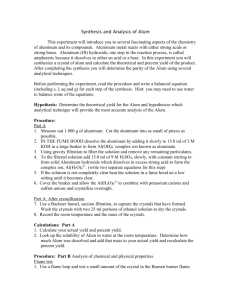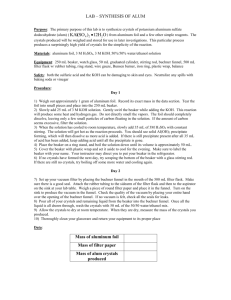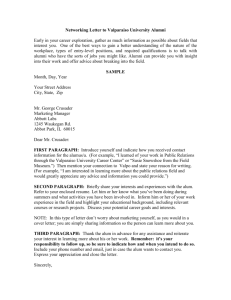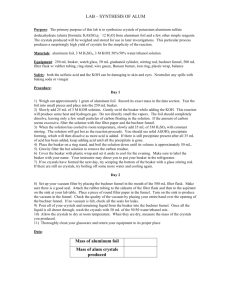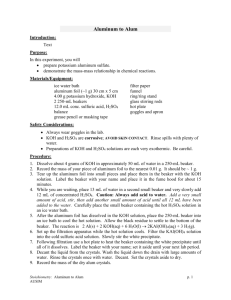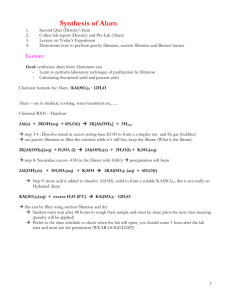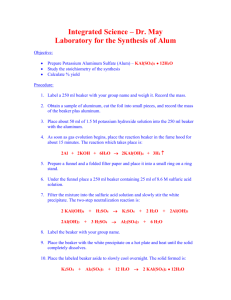AP CHEMISTRY SYNTHESIS OF ALUM (KAl(SO4)2 12H2O) In this
advertisement
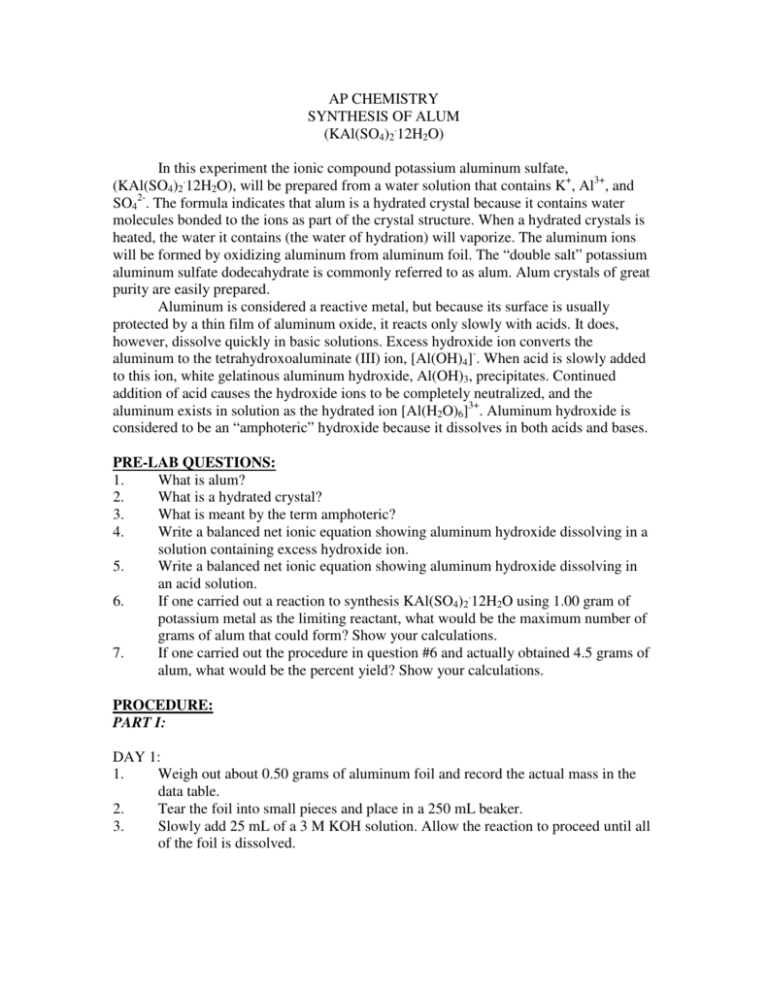
AP CHEMISTRY SYNTHESIS OF ALUM (KAl(SO4)2.12H2O) In this experiment the ionic compound potassium aluminum sulfate, (KAl(SO4)2.12H2O), will be prepared from a water solution that contains K+, Al3+, and SO42-. The formula indicates that alum is a hydrated crystal because it contains water molecules bonded to the ions as part of the crystal structure. When a hydrated crystals is heated, the water it contains (the water of hydration) will vaporize. The aluminum ions will be formed by oxidizing aluminum from aluminum foil. The “double salt” potassium aluminum sulfate dodecahydrate is commonly referred to as alum. Alum crystals of great purity are easily prepared. Aluminum is considered a reactive metal, but because its surface is usually protected by a thin film of aluminum oxide, it reacts only slowly with acids. It does, however, dissolve quickly in basic solutions. Excess hydroxide ion converts the aluminum to the tetrahydroxoaluminate (III) ion, [Al(OH)4]-. When acid is slowly added to this ion, white gelatinous aluminum hydroxide, Al(OH)3, precipitates. Continued addition of acid causes the hydroxide ions to be completely neutralized, and the aluminum exists in solution as the hydrated ion [Al(H2O)6]3+. Aluminum hydroxide is considered to be an “amphoteric” hydroxide because it dissolves in both acids and bases. PRE-LAB QUESTIONS: 1. What is alum? 2. What is a hydrated crystal? 3. What is meant by the term amphoteric? 4. Write a balanced net ionic equation showing aluminum hydroxide dissolving in a solution containing excess hydroxide ion. 5. Write a balanced net ionic equation showing aluminum hydroxide dissolving in an acid solution. 6. If one carried out a reaction to synthesis KAl(SO4)2.12H2O using 1.00 gram of potassium metal as the limiting reactant, what would be the maximum number of grams of alum that could form? Show your calculations. 7. If one carried out the procedure in question #6 and actually obtained 4.5 grams of alum, what would be the percent yield? Show your calculations. PROCEDURE: PART I: DAY 1: 1. Weigh out about 0.50 grams of aluminum foil and record the actual mass in the data table. 2. Tear the foil into small pieces and place in a 250 mL beaker. 3. Slowly add 25 mL of a 3 M KOH solution. Allow the reaction to proceed until all of the foil is dissolved. 4. 5. 6. 7. Remove any undissolved solids such as carbon particles by filtering the solution through filter paper and funnel while the solution is hot. Rinse the filter paper with a small amount of distilled water. At this point the solution contains [Al(OH)4]- and K+ ions, along with excess OHions. Cool the solution and then acidify it SLOWLY, with constant stirring, using 35 mL of 3 M H2SO4. The solution will get very hot because you are adding strong acid to the strongly basic solution. a. Solid Al(OH)3 will first precipitate and then dissolve as more sulfuric acid is added. b. If a precipitate still remains, filter the solution and discard the solids. Boil the solution on the hot plate until water has evaporated to give a volume of about 50 mL of solution. Cool the solution and cover the beaker with Parafilm. Allow it to rest undisturbed until the next class period. Be certain your name is on the beaker. DAY 2: 1. Cool the solution from yesterday in an ice bath for 15 minutes, keeping it as motionless as possible. a. Use the trough in your cabinet as the container for the ice bath. You will need one trough per table (you can put more than one beaker in each ice bath). b. Crystals of alum should grow in the beaker. c. If no crystals form, scrape the bottom of the beaker with a stirring rod to create a rough place where crystals may begin to grow, or add a seed crystal of alum. If you don’t get crystals forming after scraping the beaker, let the teacher know so that a seed crystal can be added. d. If there are still no crystals forming, reheat the solution until more water has evaporated and then cool the solution again. e. Rapid cooling in an ice bath causes very small crystals to grow; slow overnight cooling allows the formation of larger crystals. 2. Mass a piece of filter paper (after tearing it to fit into the funnel). Record this mass in the data table. 3. Collect the alum crystals by filtration using the filter paper massed in setp 2. Pour the filtrate (solution) into the water beaker at the front of the room. 4. Wash the crystals with 50 mL of a 50% by volume water and ethanol mixture (this has already been made into a 50% mixture and is on your lab table). Alum crystals are very soluble in water, but not in ethanol. So, the crystals will not be very soluble in the water/ethanol mixture. 5. Allow the crystals to dry at room temperature. Put your piece of filter paper (which has the alum on it) on a watch glass. Put your name on a piece of tape and place it on the bottom of the watch glass. Put your watch glass in the fume hood. PART II: DAY 3: Determine the amount of water of hydration in alum crystals. 1. 2. 3. 4. 5. 6. 7. Mass the filter paper with the alum crystals from yesterday. Record this value in the data table. Find the mass of a clean, dry crucible and cover. Record this mass in the data table. Add about 2 grams of the alum crystals that you created to the crucible. Find the mass of the crucible, cover, and crystals. Record in the data table. Set the crucible in a triangle held in a ring on a ring stand. Cover the crucible loosely with the cover and heat very gently. a. The alum crystals melt, and the water that is contained in the hydrated crystals (the water of hydration) will vaporize. b. It is important that the escaping water vapor does not carry any of the anhydrous (without water) alum along with it, so be sure that the crystals are heated very gently at first. After the vapor appears to be driven off, heat more strongly for five more minutes. Cool the crucible to room temperature and find the mass of the crucible, cover, and anhydrous alum. Record this in the data table. DATA: Mass of aluminum foil Mass of filter paper Mass of filter paper + alum Mass of alum produced g g g g Water of Hydration Data: Mass of crucible + cover Mass of crucible + cover + crystals Mass of crucible + cover + anhydrous alum Mass of alum crystals Mass of anhydrous alum Mass of water driven off g g g g g g CONCLUSION: PART I: 1. Why would you NOT expect a 100% yield of crystals? 2. How does the solubility of alum in water change with temperature? 3. Why should you NOT wash the crystals with pure water? 4. What do your crystals look like? 5. Calculate the theoretical yield of alum assuming that aluminum was the limiting reactant and that the foil was 100% aluminum, and calculate your percent yield. Show your work for both parts. PART II: 6. Calculate the moles of water driven off (water of hydration). 7. Calculate the moles of KAl(SO4)2 produced. 8. Calculate the ratio of moles of water to moles of KAl(SO4)2. 9. Give the calculated formula of alum, KAl(SO4)2.XH2O, where X = the ratio of moles of water to moles of KAl(SO4)2 (which is the answer to question #8 above). KAl(SO4)2._____H2O 10. Compare the formula found in question #9 to the actual formula for alum. In other words, how close is your formula to the true formula? 11. Do the results of your analysis support that you created alum in Part I? SUPPORT YOUR ANSWER. SYNTHESIS OF ALUM LAB TEACHER NOTES GRADING RUBRIC: (1 pt) Title: Lab #1 – Synthesis of Alum (2 pt) Purpose: To synthesize alum and determine moles of water in the hydrate (1 pt) Chemicals: aluminum foil, potassium hydroxide, sulfuric acid, and 50% ethanol/water mixture (7 pt) Pre-Lab Questions – 1 point per answer (1 pt) Procedure (10 pt) Data: Tables Table #1 has 4 blanks Table #2 has 6 blanks (36 pt) Conclusion: Write out all 11 questions to answer at a later time. (question #5 has 2 questions, so there are 12 questions total) 3 points per question 58 points total for lab NECESSARY EQUIPMENT AND CHEMICALS: Day 1: 6 bottles 3 M KOH (25 mL per group) 6 bottles 3 M H2SO4 (35 mL per group) – 150.3 mL conc per 900 mL solution Al foil Filter paper Parafilm Day 2: Ice for ice 50% ethanol + water mixture

